Trees are an integral part of the landscape in South Carolina and can be seen in almost every corner of the state. Trees have been a part of this area since its earliest settlers, from towering pines that line the shoreline to majestic oaks that provide shade for family picnics. Throughout history, they have provided lumber for building homes and ships and have provided food, fuel, and shelter. Trees are also a source of beauty and comfort when one needs to escape everyday life.
In addition to their practical uses, trees serve as important environmental resources by reducing air pollution through photosynthesis, protecting soil from erosion, and providing habitat for wildlife. They are essential components in any healthy ecosystem, so it is indispensable to protect them whenever possible. Planting native species helps ensure their survival for future generations to enjoy!

Here are a few of our favorite South Carolina native tree species. Let’s get started!
1. American Holly
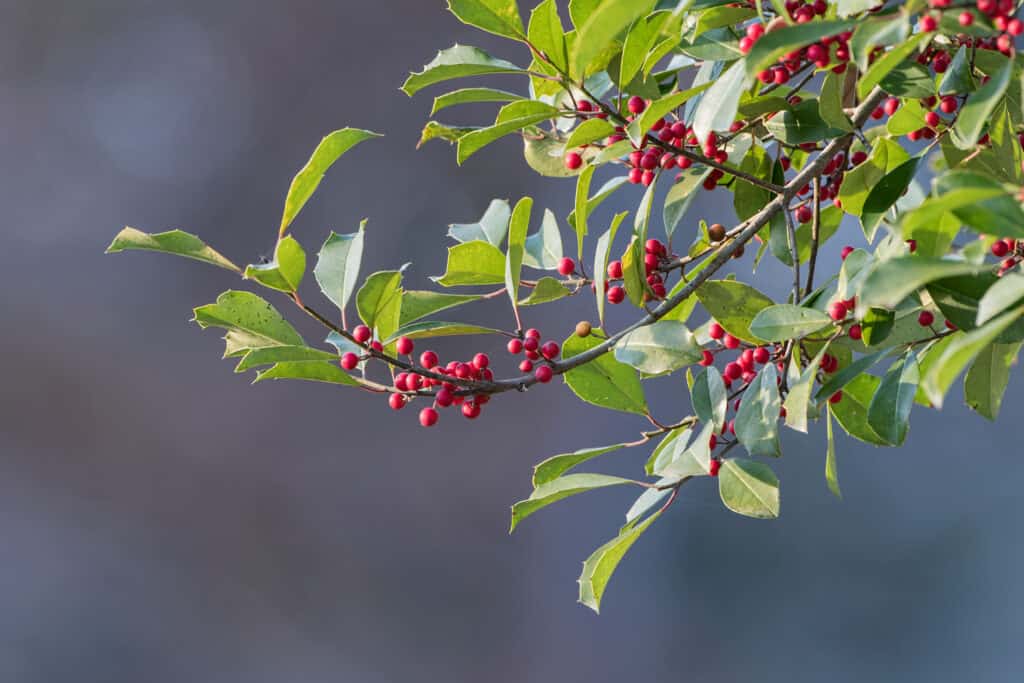
American holly is a species of holly native to the southeastern United States.
©Bonnie Taylor Barry/Shutterstock.com
American holly (Ilex opaca) is a species of holly native to the southeastern United States. The species is evergreen and can grow up to 98 feet tall, with glossy leaves and bright red berries in the fall and winter. Many birds, including bluebirds, robins, and mockingbirds, eat the fruits of the American holly. In addition to providing sustenance for these birds, the American holly also serves as a host plant for Henry’s elfin butterfly larvae. This species of butterfly lays its eggs on the underside of American holly leaves, which provides food for their caterpillars when they hatch.
2. Cabbage Palmetto

The cabbage palmetto has a thick, fibrous trunk that supports its large fronds.
©iStock.com/JillianCain
The cabbage palmetto (also known as sabal palmetto) is the official South Carolina state tree. This palm tree can grow to a height of 65 feet and has a thick, fibrous trunk supporting its large fronds. The fruits produced by this tree are eaten by birds such as robins, cedar waxwings, mockingbirds, and brown thrashers, as well as mammals like raccoons and opossums. These fruits provide an important food source for wildlife in South Carolina’s forests and beaches.
Furthermore, the leaves of the cabbage palmetto tree have been used for centuries to make woven hats or roofs for houses — a practice still used today in some parts of the state.
3. Eastern Hemlock
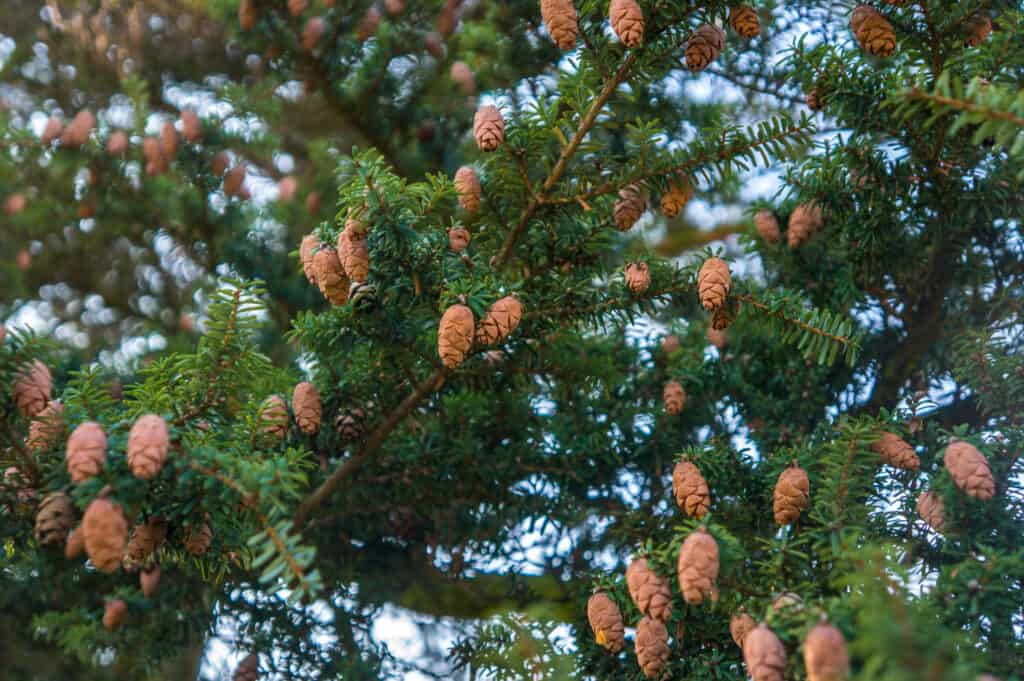
The eastern hemlock is an evergreen tree native to the eastern United States and Canada.
©iStock.com/Sara Lissaker
The eastern hemlock, Tsuga canadensis, is an evergreen tree native to the eastern United States and Canada. It typically grows between 40–100 feet tall, with a trunk diameter of up to three feet. The bark is scaly and reddish-brown, while the foliage is dark green on top but paler beneath.
Its cones are small and round, producing seeds that many birds eat, such as grouse, thrushes, and woodpeckers. The tree also provides excellent nesting cover for these same species of birds due to its dense branches, which form an umbrella shape when mature. Additionally, it helps protect other wildlife by providing shelter from snowfall or strong winds.
4. Eastern Red Cedar
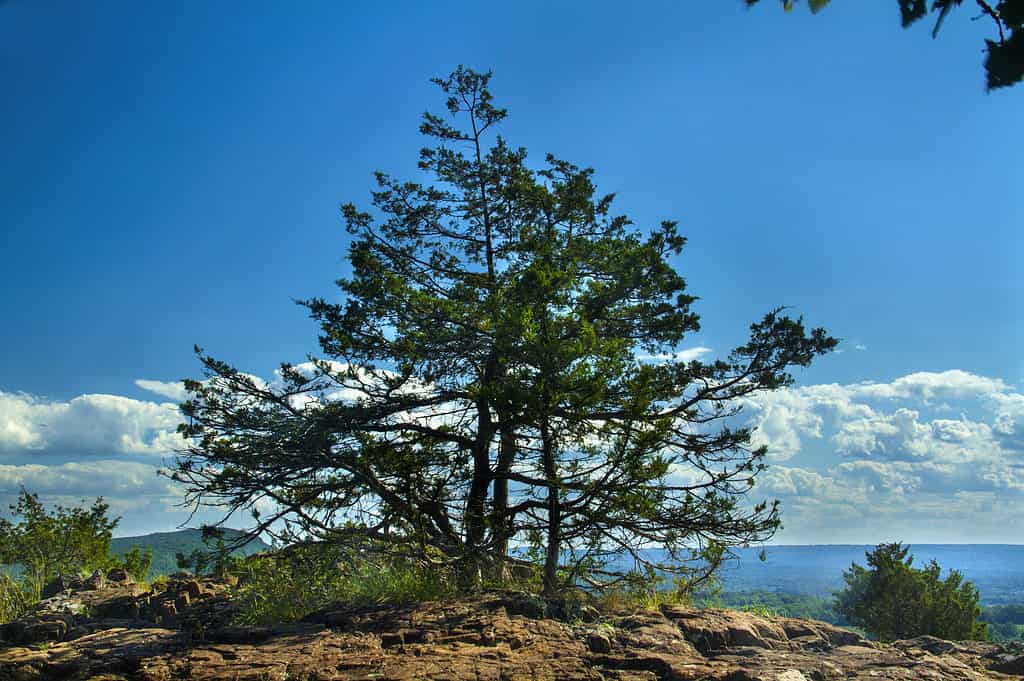
The eastern red cedar creates a habitat for various species while providing sustenance for many others.
©iStock.com/Holcy
Eastern red cedar, Juniperus virginiana, is a native tree to South Carolina with many benefits. Cedar waxwings, purple finches, and bluebirds eat its fruits. It also provides nesting sites for hummingbirds, warblers, and doves. The larvae of great purple hairstreaks feed on eastern red cedars. Eastern red cedar is an important part of South Carolina’s ecosystem, creating a habitat for various species while providing sustenance for many others.
5. Southern Magnolia
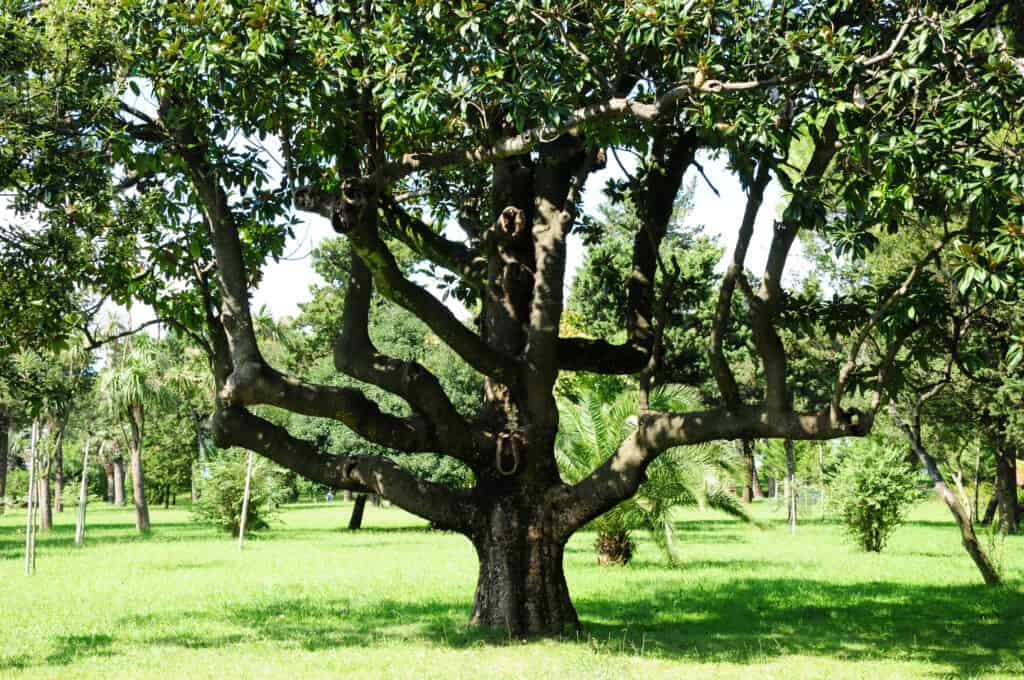
The southern magnolia provides good nesting material for birds, such as the yellow-bellied sapsucker and red-cockaded woodpecker.
©Vahan Abrahamyan/Shutterstock.com
The southern magnolia (Magnolia grandiflora) is a species of tree native to South Carolina, and it has many benefits for the local wildlife. In particular, its leaves and branches provide good nesting material for birds, such as the yellow-bellied sapsucker and red-cockaded woodpecker. The seeds produced by this tree are also eaten by these bird species, providing them with sustenance throughout the year.
6. American Beech
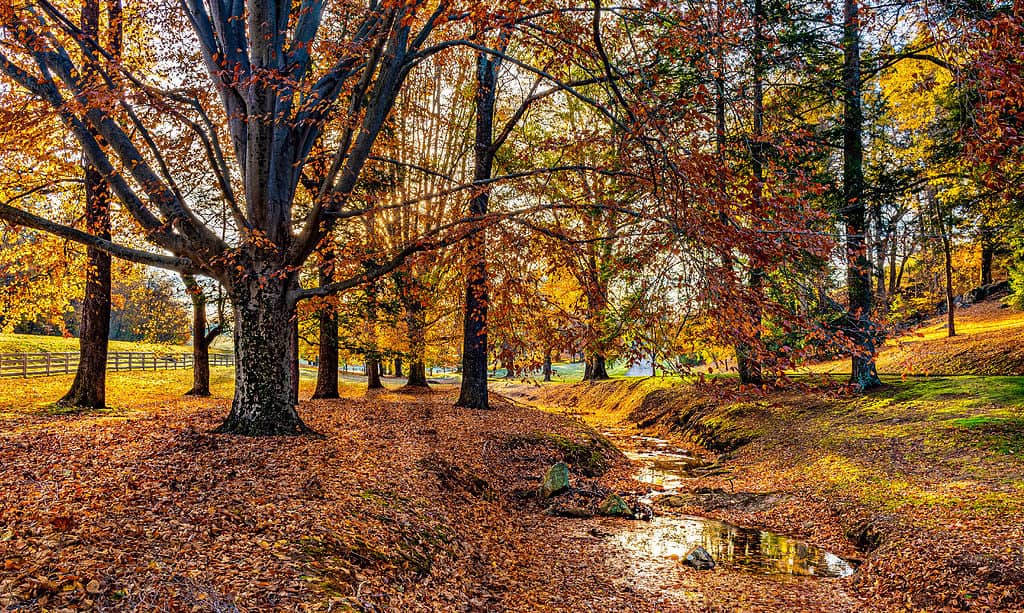
American beech produces edible nuts, enjoyed by birds such as the blue jay,
chickadee
, and tufted titmouse.
©Gerry Bishop/Shutterstock.com
American beech (Fagus grandifolia) is a species of beech tree that is native to South Carolina. It has smooth, gray bark and ovate leaves with serrated edges. This deciduous tree also produces edible nuts, enjoyed by birds such as the blue jay, chickadee, and tufted titmouse. In addition to providing food for these feathered friends, American beech trees are a favorite nesting spot for pileated woodpeckers.
7. Bald Cypress

The bald cypress is found primarily in wetland areas.
©Jeff Holcombe/Shutterstock.com
The bald cypress, Taxodium distichum, is a native tree species of South Carolina. The species is found primarily in wetland areas and grows up to 35–100 feet tall with a trunk up to six feet in diameter. Its bark is brownish-red or cinnamon and has a fibrous texture with shallow ridges and furrows. The leaves are needlelike and arranged in pairs that spiral around the branchlets; they turn orange-brown before dropping in autumn. This species produces cones containing light brown seeds, which ducks and sandhill cranes favor.
8. River Birch

River birch produces small seeds eaten by many birds, including chickadee, finch, tanager, and grouse.
©Gerry Bishop/Shutterstock.com
River birch, Betula nigra, is a species of birch tree native to South Carolina. It grows in areas near water, such as wetlands and riverbanks. The leaves are dark green with a smooth texture, and the bark is reddish-brown. River birch produces small seeds eaten by many birds, including chickadee, finch, tanager, and grouse. Nuthatches also feed on these seeds during the winter, when food sources can be scarce. In addition to being a source of food for wildlife, river birches provide excellent nesting sites for various bird species due to their dense foliage canopy, which provides shelter from predators and harsh weather conditions.
9. Black Gum Tree

The leaves on the black gum tree change color throughout the year.
©Photo by David J. Stang / CC BY-SA 4.0, via Wikimedia Commons – License
The black gum tree (Nyssa sylvatica) is native to South Carolina and commonly referred to as the “Bee Tree” due to its production of nectar for bees. It produces small, blueish-black fruit eaten by many species, such as wood duck, bluebirds, purple finch, yellow finch, opossum, and squirrels.
The leaves on the black gum tree change color throughout the year — in spring, they produce a deep green hue while transitioning into brilliant shades of scarlet red in autumn. Its bark is light or dark brown with characteristic ridges that often appear scaly or furrowed. This tree can reach heights of up to 82 feet tall and has an estimated life span of over 650 years, making it a great addition to any garden!
10. Oak

Oak trees make great windbreakers as well as provide habitat for wildlife.
©iStock.com/WerksMedia
Oak trees (Quercus) are some of the most common and diverse trees found in South Carolina. Many types of oak are found in the state, and all of them provide excellent shade for yards due to their large canopy size. They also make great windbreakers as well as provide habitat for wildlife. Oak wood is also extremely durable, making it perfect for furniture or other woodworking projects that require strong materials.
Oak trees provide food for many animals and birds, including titmouse, turkey, woodpecker, squirrels, and deer, which find the acorns produced by these trees delicious. The Carolina wren (South Carolina’s state bird) also benefits from oaks, as they use the leaves of these trees to line their nests and the acorns to fill their bellies. Oaks also provide larvae with plants to feed on when they are growing.
Summary of 10 Incredible Trees Native to South Carolina
The trees on this list benefit many animals – here are just a few.
| # | Tree | Animals it Benefits |
|---|---|---|
| 1 | American Holly | Bluebirds, robins, mockingbirds, and Henry’s elfin butterflies |
| 2 | Cabbage Palmetto | Fruit is eaten by birds, raccoons, and opossums |
| 3 | Eastern Hemlock | Grouse, thrushes, and woodpeckers |
| 4 | Eastern Red Cedar | Cedar waxwings, purple finches, bluebirds, hummingbirds, warblers, and doves. |
| 5 | Southern Magnolia | Yellow-bellied sapsucker and red-cockaded woodpecker |
| 6 | American Beech | Blue jay, chickadee, tufted titmouse and pileated woodpeckers |
| 7 | Bald Cypress | Ducks and sandhill cranes |
| 8 | River Birch | Chickadee, finch, tanager, grouse, and nuthatches |
| 9 | Black Gum Tree | Bees, wood ducks, bluebirds, purple finch, yellow finch, opossums, and squirrels |
| 10 | Oak | Carolina wren, titmouse, turkey, woodpecker, squirrels, and deer |
The photo featured at the top of this post is © iStock.com/Lyudmila Chetvertnykh
Sources
- South Carolina Native Plant Society, Available here: https://scnps.org/education/south-carolina-native-tree-identifier
- Clemson Trees, Available here: http://www.northinlet.sc.edu/wp-content/uploads/2019/10/ClemsonTrees.pdf
- South Carolina Wildlife Federation, Available here: https://www.scwf.org/native-plant-list
- South Carolina Department of Natural Resources, Available here: https://www.dnr.sc.gov/marine/mrri/acechar/speciesgallery/Plants/LiveOak/index.html
Thank you for reading! Have some feedback for us? Contact the AZ Animals editorial team.






